Llansilin is a village in Montgomeryshire, situated some five miles west of Oswestry. The community includes Llansilin village, and the hamlets of Moelfre and Rhiwlas as well as the remote parish of Llangadwaladr, and covers a large rural area. The church in Llansilin is dedicated to Saint Silin, and located in the Churchyard is the Parish War Memorial, which commemorates the men of the Parish who fell during both World Wars. There is also an identically named memorial in the Llansilin Memorial Hall, which also includes the names of all those who served in the Great War and survived.
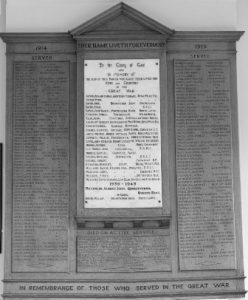
The Great War, 1914-1918
Edward Bather, Private, 201101, Royal Welsh Fusiliers. Edward was the son of Lloyd and Mary Jane Bather, of Erwgerrig, Glyn Ceiriog. He worked as a granite quarryman prior to the war. Edward enlisted into the 4th Battalion, Royal Welsh Fusiliers soon after the outbreak of war, and after completing his training, was drafted to France in the Spring of 1917, joining the 1/4th Battalion, Royal Welsh Fusiliers, which was the Pioneer Battalion to the 47th (2nd London) Division. Early in 1917 the Division moved north to Belgium, and took part in the Battle of Messines, and then in November 1917 fought at the Battle of Cambrai. In March 1918 the Division was situated near St. Quentin, and faced the German Spring Offensive here on 21 March, fighting at the Battle of St Quentin, and then in the rear-guard action at the First Battle of Bapaume. In August 1918 the British attacked on the Somme, and the Division fought in the Battle of Albert, and then at the Battle of Bapaume. The Division then rested and rebuilt for a while, before taking part in the Final Advance in Artois. Edward survived the war, but it had taken a toll on his health. He died of heart disease in Oswestry Cottage Hospital on 9 October 1920, aged 26. Nothing further is known of him, as he is not commemorated by the CWGC.
Richard Thomas Bather, Private, 31539, Queen’s Own (Royal West Kent Regiment). Richard was the son of John and Jane Bather, of Tan-y-Graig, Pandy, Glyn Ceiriog. He enlisted into the army at Wrexham, and was initially posted to the 1/5th Battalion, Border Regiment. Richard was then posted to France in the Spring of 1918, and was transferred to the 7th Battalion, Queen’s Own (Royal West Kent Regiment), which was attached to 53 Brigade, 18th (Eastern) Division. The Division had suffered heavy casualties following the launching of the first phase of the German Spring Offensive on 21 March 1918, where the 7th Queen’s Own had been virtually annihilated. Richard would have been among a large number of re-enforcements drafted to the battalion on 31 March 1918. The battered Division then took over a section of front line at Gentelles, south of the River Somme, where it saw further fighting before being relieved and moving into reserve. In the first week of May 1918, the Division moved back into the line to the west of Albert, and the 7th Queen’s Own held the village of Laviéville. A relatively peaceful period then followed, before the Division took part in the great Allied offensive, which was launched on 21 August 1918, and attacked the Germans from the direction of Warloy, to the south of the 38th (Welsh) Division. Over the coming days both Division worked together, driving the Germans back across the old Somme battlefields of 1916. On 27 August 1918 the 7th Queen’s Own launched an assault on Trônes Wood, gaining its objectives, but suffering 90 casualties in so doing. Richard had been killed in action during the fighting that day. The 18-year-old is buried in Quarry Cemetery, Montauban, France. His brother Wynn had been killed nearby, almost two years earlier.
Wynn Bather, Private, 8540, Royal Welsh Fusiliers. Wynn was the son of John and Jane Bather, of Tan-y-Graig, Pandy, Glyn Ceiriog. He worked as a farm labourer at Pontricket, Tregeiriog prior to the war. Wynn enlisted into the 4th Battalion, Royal Welsh Fusiliers at Chirk soon after the outbreak of war, and was posted to France early in 1916, joining the 1/4th Battalion, Royal Welsh Fusiliers, which was the Pioneer Battalion to the 47th (2nd London) Division. Wynn probably joined the battalion at Loos, where it was working hard, constructing dug-outs and trenches. The Division then moved slightly south to the Villers-au-Bois sector, and the 4th RWF began work on dugouts around Cabaret Rouge and Zoave Valley. The Division moved out of the line at the end of July, and moved south again, to join the great Somme offensive, reaching Albert by 1 September, and the 4th RWF again began its Pioneer work, repairing the road to Mametz. Wynn was killed in action whilst working on the Mametz Road on 3 September 1916, probably by German artillery fire. The 24-year-old is buried in Caterpillar Valley Cemetery, Longueval, France. His brother, Richard Thomas Bather, was killed nearby almost two years later.
David William Breeze, Lance Corporal, 12290, King’s Shropshire Light Infantry. David was the son of David and Jane Breeze, of Trefonen. He worked as a corrugated iron packer at Shotton, Flintshire prior to the war. David enlisted into the 6th Battalion, King’s Shropshire Light Infantry on 3 September 1914. The battalion formed at Shrewsbury in September 1914, joining 60 Brigade, 20th (Light) Division at Aldershot, and on 22 July 1915 landed at Boulogne. On 26 July 1915 the Division moved to the Fleurbaix Sector for trench familiarisation and training. When the Battle of Loos was launched on 25 September 1915 the Division fought a diversionary attack towards Fromelles. Later that year it moved north, and fought at the Battle of Mount Sorrel alongside the Canadian Corps. The Division then fought through the Somme Offensive, at the Battles of Delville Wood, Guillemont, Flers-Courcelette, Morval and Le Transloy, and took part in the advance to the Hindenburg Line in March 1917. Later that year the Division fought at Third Ypres, at the Battles of Langemarck, the Menin Road, and Polygon Wood, before moving south in November, to take part in the Battle of Cambrai. The Division remained in the area between Cambrai and St. Quentin over the winter of 1917/18. David’s health broke down over that final winter in France, and he was discharged from the army as medically unfit on 6 March 1918, returning home, before marrying Ruth Morris, of Sunnyside, Llansilin, in 1920. David eventually died as a result of his service during the war, and his widow, Ruth, was granted a war pension. Ruth had lost a brother, Arthur Morris, during the war. David was buried in St. Silin’s Churchyard, Llansilin. He is not commemorated by the CWGC, nor is he commemorated on the Llansilin war memorial.
Richard Thomas Coleman, Private, 35360, Royal Welsh Fusiliers. Richard was born at Llansilin in 1892, the son of John Thomas Coleman, a Farm Bailiff, and Mary Ann Coleman (nee Richards). By 1901 the family had moved to Tan-y-Ffridd, Llanrhaeadr Ym Mochnant, and by 1911 Richard was living at Plas Maengwynedd, Llanrhaeadr, where he worked as a farm carter. Richard enlisted at Welshpool into the 3/1st Battalion, Montgomeryshire Yeomanry on 14 May 1915, and was posted to Park Hall Camp, Oswestry for training, before being posted to the 1/1st Battalion, Montgomeryshire Yeomanry, which was at Thetford, attached to the 1st Mounted Division. On 4 March 1916 the 1st Mounted Division sailed for Egypt to join the EEF. On 4 March 1917 the battalion merged with the Welsh Horse Yeomanry to form the 25th (Montgomery & Welsh Horse Yeomanry) Battalion, Royal Welsh Fusiliers, as part of the newly formed 231 Brigade, 74th (Yeomanry) Division. The Division assembled in Egypt as part of the EEF, before crossing the Suez Canal into the Sinai, and saw its first major action during the Second Battle of Gaza. The battle was a failure, and the EEF was re-organised under a new commander, Sir Edmund Allenby, before launching the Third Battle of Gaza on the night of 31 October 1917. This assault was launched along a winder front, running from Gaza to Beersheba, and this time the EEF prevailed, opening the door to Jerusalem. Richard was wounded in the thighs by machine-gun fire on 31 October, during the initial assault, and was treated at the 229th Field Ambulance, before being evacuated back to the 19th General Hospital in Alexandria, where he died of his wounds on 5 December 1917. The 26-year-old was buried in Alexandria (Hadra) War Memorial Cemetery, Egypt. Richard is not commemorated on the Llansilin war memorial, but on his parent’s grave at Llanarmon Mynydd Mawr.
Evan Davies, Private, 23153, Royal Welsh Fusiliers. Evan was the son of Allen and Margaret Davies, of Brynyffynon, Llangedwyn. Following the death of his mother, Evan went to work as a farm servant at Caer Fach, Llansilin. Evan enlisted into the Royal Welsh Fusiliers at Llangollen soon after the outbreak of war and was posted to the 10th Battalion, Royal Welsh Fusiliers, which was on Salisbury Plain, attached to 76 Brigade, 25th Division. On 27 September 1915 the Division landed at Boulogne, and two weeks later 76 Brigade transferred to the 3rd Division, which was holding the line at St. Eloi, near Ypres. The Division saw heavy fighting during the Actions of the Bluff in February 1916 and then at the Actions of the St Eloi Craters from 27 March to 16 April, and came under a gas attack for the first time on 29/30 April. By the middle of June, the Division had moved out of the Ypres Salient to billets around Eperlecques, where intense training was carried out prior to moving to the Somme sector by 2 July. The main Somme offensive had opened on the previous day, and the 3rd Division was ready to enter the fray, bivouacking at Bronfay Farm by 9 July and on 13 July moved into the captured German lines at Montauban Alley. The 10th RWF took part in heavy fighting over the coming days, and on 19 July received orders for an assault on Delville Wood. Just after midnight the following day the battalion moved forwards and became caught in in terrible fighting within the wood, the fighting of such severity that two men of the battalion were awarded the Victoria Cross. On 25 July the shattered battalion was relieved and moved into reserve, and did not move back into the line until 17 August, when the battalion attacked Lonely Trench. On 23 August the Division moved out of the line to rest and moved to Noeux-les-Mines, near Loos. After a month there, the Division moved back into a rest area for further training before moving back south to the Somme and by 12 November took over trenches at Serre. On the following day, 13 November 1916, the Division launched an assault against the German positions at Serre. The 10th RWF reached Serre village, but the flanking battalions failed to keep up, and heavy losses were suffered, with almost 300 officers and men killed, wounded, or missing. After wintering on the Somme, the Division moved to the Arras sector in February 1917, and took part in the Battle of Arras from 9 April to 16 May, suffering heavy casualties. The Division remained in the same area over the coming months. On 15 July 1917 a party of the 10th RWF took part in a bombing raid on the German lines. Evan and one officer were killed during the raid. Evan was 27-years-old when he was killed that day, and is buried in Louverval Military Cemetery, Doignies, France. Two of his brothers, John and William, were also killed during the war.
Evan Goronwy Davies, Private, 23048, Royal Welsh Fusiliers. Evan was born in Llansilin in 1896, the son of Edward and Emma Davies. By 1901 the family had moved to Craig Fryn, Garth Trevor. He worked as a cowman prior to enlisting at Birkenhead into the Royal Welsh Fusiliers, and was posted to the 9th Battalion, Royal Welsh Fusiliers. The battalion had formed at Wrexham in September 1914, before moving to Tidworth to join 58 Brigade, 19th (Western) Division. On 19 July 1915 Evan landed in France with the battalion, and the entire 19th Division then moved to the Nursery Sector at Calonne for trench initiation alongside the Dehra Dun Brigade. The infantry battalions of the division then began carrying out the usual routines of rotating in the trenches: four days in the front line; four in support; and four in reserve, interspersed with training regimes and carrying out working parties and trench raids. Just south, the British launched a great offensive around the town of Loos on 25 September 1915, and the 19th Division was ordered to attack from its positions at the same time, to attempt to draw enemy attention away from the main battle area. The attacking battalions of the 19th Division were in place by 04.00, and then at 05.50 the men climbed out of their trenches to launch their assault, behind a gas and smoke screen. The assault was a disaster, and heavy casualties were suffered by the 19th Division for no gain. Evan had been killed in action during the ill-fated attack that day. The 19-year-old has no known grave and is commemorated on the Loos Memorial, France. Evan is not commemorated on the Llansilin war memorial.
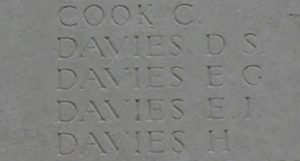
John Davies, Private, 12565, South Lancashire Regiment. John was the son of Allen and Margaret Davies, of Brynyffynon, Llangedwyn. He enlisted into the South Lancashire Regiment on 4 September 1914, and was posted to their Depot. On 7 July 1915 John embarked for France and was posted to the 2nd Battalion, South Lancashire Regiment, which was in the Ypres Salient attached to 7 Brigade, 3rd Division. On 18 October the Brigade transferred to the 25th Division, and then a week later, the 2nd South Lancs transferred to 75 Brigade, 25th Division. During October the Division moved south to the Ploegsteert sector, and remained there until March 1916, when it moved south and began a scheme of training before continuing its move south, taking over positions at Neuville-St. Vaast in the middle of April and on 28 May suffered the explosion of an underground German mine, which was followed by a heavy artillery bombardment. At the end of June, the Division moved further south to the Somme sector, and attacked on 3 July near Thiepval. John took ill several weeks into the Somme offensive, and was invalided home on 8 September suffering from typhus. After recovering, John embarked at Southampton on 11 January 1917, and re-joined the 2nd South Lancs on 20 January. The Division was by now back in the Ploegsteert Sector, where it remained for the months leading up the Battle of Messines on 7 June 1917. After fighting at Messines, the Division moved north, to the Railway Wood sector, and took part in the Third Battle of Ypres. In September the Division was relieved, and moved to the Noeux-Les-Mines sector. By March 1918 the Division was in position around Bullecourt in reserve, and the men could hear the opening artillery barrage which heralded the opening of the German Spring offensive on 21 March 1918. The Division advanced towards Favreuil and reinforced the Vaulx to Morchies Line, and soon came into contact with the attacking German troops. The Division was pushed back towards Gommecourt over the coming days, before being relieved and moved north to the St. Hilaire sector to rest. Unfortunately, the Germans launched the second phase of their offensive on 9 April, and the 2nd South Lancs, in reserve, was ordered to be readied to move at short notice. On 10 April 1918, with the situation in the front dire, and the line broken, the 2nd South Lancs launched a counter-attacked near Ploegsteert village. John was killed in action during the heavy fighting which followed that day. The 33-year-old has no known grave and is commemorated on the Ploegsteert Memorial, Belgium. Two of his brothers, Edward and William, were also killed during the war.
John Daniel Davies, Private, 28891, The Loyal North Lancashire Regiment. John was the son of John Charles Davies and Mary Davies, of Pentrecefn-Bach, Creiglwyn. He enlisted into the 5th Lancers, but was then transferred to the South Lancashire Regiment. Upon completing his training, John was transferred to the 2/5th Battalion, The Loyal North Lancashire Regiment. The battalion was attached to 170 Brigade, 57th (West Lancs) Division, and on 9 February 1917 landed at Le Havre. The Division then moved to the Nursery Sector at Fleurbaix for trench initiation and training, before moving to positions at Ploegsteert Wood, near Ypres, in June 1917, and took up the right flank position for the Allied assault on Messines Ridge on 7 June. The Division was not directly involved in the battle, but saw and felt the massive series of mine explosions which heralded the launching of the assault. The Division had a brief spell out of the line later that year before moving into the front line at Poelcapelle on 24 October 1917, and took part in the Second Battle of Passchendaele. Two weeks later the Division was relieved, and enjoyed a brief rest behind the lines before moving south to the Wez Macquart Sector. On 5 February 1918 the British army was re-organised, due to a shortage of men, and the 2/5th Loyal’s became converted to the Pioneer Battalion to the 57th Division. On 10 March 1918 the battalion was billeted near Éstaires, when one of the billets was hit by a German shell, killing sixteen men and wounding fourteen others. John was among the men killed. The 23-year-old is buried in ANZAC Cemetery, Sailly-sur-La-Lys, France.
Robert Thomas Davies, Private, 61101, Royal Welsh Fusiliers. Robert was the son of Thomas and Mary Davies, of Bryn Coch, Rhydycroesau. He worked on his parents’ farm prior to the war. Robert enlisted at Llanrhaiadr into the 3rd Battalion, Royal Welsh Fusiliers, and was posted to Litherland Camp, Liverpool for training. Robert had not long been in khaki when he took ill, and he died in hospital in Liverpool of bronchitis on 18 February 1917. The remains of the 27-year-old were brought home for burial in Christ Church Churchyard, Rhydycroesau.
William Davies, Private, 12335, South Lancashire Regiment. William was the son of Allen and Margaret Davies, of Brynyffynon, Llangedwyn. William was working as a collier at Ashton-in-Makerfield when war erupted, and he enlisted at Warrington into the 6th Battalion, South Lancashire Regiment on 2 September 1914. The battalion formed at Warrington, before moving to Tidworth to join 38 Brigade, 13th (Western) Division. In January 1915 the Division moved to Winchester and on 13 June 1915 sailed from Avonmouth for Alexandria, moving to Mudros before being landed at Cape Helles, Gallipoli from 6 July 1915, relieving the 29th Division. The Division left and returned to Mudros at the end of the month, before landing at ANZAC Cove from 3 August 1915, and joined up with the Anzac’s for their offensive soon afterwards, attacking and holding, for a short period, Sari Bair. William was killed in action during the attack on 10 August 1915. The 29-year-old has no known grave and is commemorated on the Helles Memorial, Gallipoli. Two of his brothers, Evan and John, were also killed during the war.
Enoch Edwards, Private, 30452, Royal Welsh Fusiliers. Enoch was the son of Elias and Mary Edwards, of Rhydycroesau. He worked as a farm labourer prior to enlisting into the 2/1st Battalion, Montgomeryshire Yeomanry at Oswestry on 10 February 1915, and on 17 September 1916 was transferred to the 4th Battalion, Royal Welsh Fusiliers. On 20 September 1916 Enoch embarked at Devonport for Salonika aboard the HT Transylvania, and joined the 11th Battalion, Royal Welsh Fusiliers, which was attached to 67 Brigade, 22nd Division. The British and French had sent a strong force to Salonika early in the war to aid the Greeks, following the invasion of Serbia by a combined Austrian and Hungarian force, which had pushed the Serbs into Greece. The 22nd Division had been sent there in November 1915, and had already taken part in several pitched battles before Enoch arrived. He was hospitalised at two separate times, suffering from tonsilitis the first time, then of sickness the second, returning to duty at the end of November 1917. Enoch was badly wounded by shrapnel from a shell-burst during a routine spell in the trenches on 10 June 1918, and was evacuated to the 31st Casualty Clearing Station, where he died of his wounds on the following day, 11 June 1918. The 23-year-old is buried in Sarigol Military Cemetery, Kriston, Greece.
John Ellis, MM, CdeG, Gunner, 2029, Australian Field Artillery. John was born on 11 March 1895, the son of Evan and Elizabeth Ellis, of Tanygraig, Rhydycroesau. He emigrated to Australia just prior to the outbreak of war, and settled in Clarke’s Bridge, Laidley, Queensland, where he married Tryphena Jane Clarke on 20 January 1915. Ellis enlisted in Brisbane into the 14th Reinforcements for the 2nd Light Horse on 29 September 1915. The unit embarked from Brisbane, Queensland, on board HMAT Wandilla on 31 January 1916, arriving in Egypt in March 1916. On 21 April 1916 John transferred to the 11th Brigade, Australian Field Artillery, and moved to France with his new unit, disembarking at Marseilles in June 1916. John suffered a bout of trench fever during August 1917 and returned to England for treatment, but re-joined his unit on 19 March 1918. A month later he was awarded the Military Medal for conspicuous bravery and devotion to duty for action between Albert and Henencourt. The citation for the award read: ‘For conspicuous gallantry and devotion to duty during the attack on our positions opposite DERNANCOURT and ALBERT on the 5th April 1918. He went out without hesitation under heavy shell fire to mend telephone wires that had been cut. Communication on his line was constantly maintained except during a period when the line was cut by shell fire faster than it could be repaired. During this period Gunner ELLIS acted as runner between the 41st and 42nd Batteries. Owing to his courage and resource, orders from Group Headquarters were passed to 41st Battery through 42nd Battery at a critical period – when telephone lines from Group headquarters to the former Battery were out of action.’ He was also awarded the French Croix-de-Guerre in May 1918, for bravery under fire. The Australians took part in a famous victory at Villers-Bretonneux on 8 August 1918, and from 21 August took part in the great Allied advance, which ultimately won the war. On 3 November 1918 Ellis’ unit was positioned at the Sambre–Oise Canal, and Ellis was carrying a message when he was struck in the head by shrapnel, and killed. The 24-year-old is buried in Highland Cemetery, Le Cateau, France.

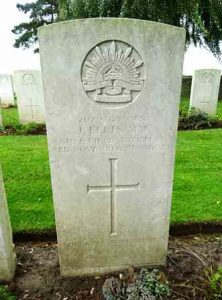
John Edward Evans, Private, 81875, Royal Army Medical Corps. John was the son of William and Margaret Evans, of Cefn-y-Braich, Llansilin. He was studying for the Wesleyan Ministry at Handsworth College when war broke out, and enlisted at Rhyl Town Hall into the Royal Army Medical Corps on 28 January 1916. He trained at Llandrindod Wells and Sheffield before embarking for Salonika at Southampton on 10 September 1916, to join the 38th General Hospital, which served the Salonika Expeditionary Force. In May 1917 John was hospitalised with enteric fever, and on 18 August was evacuated to Hospital in Malta aboard the Hospital Ship Goorkha. He was initially diagnosed as suffering from pleurisy, but his condition worsened, and John died at Valletta Hospital, Malta of tuberculosis and peritonitis on 3 April 1918. The 26-year-old is buried in Pieta Military Cemetery, Malta.
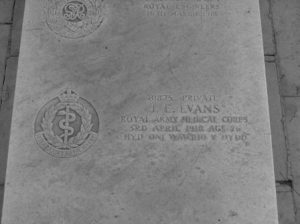
William Herbert Evans, Gunner, 77246, Royal Garrison Artillery. William was the son of William and Mary Evans, of Rhydycroesau Post Office. He worked as a carter and farmer prior to the war. William enlisted into the Royal Garrison Artillery at Oswestry on 11 December 1915, and was placed on the Army Reserve. He was mobilised on 8 May 1916 and sent to Fort Brockhurst for training, before being drafted to France in June 1916, joining the 61st Siege Battery, Royal Garrison Artillery. He served with the battery 9 April 1918, when he was wounded by gas, following the German Lys offensive, and was taken to the 33rd Casualty Clearing Station, before being sent to Hospital at Le Havre. Upon recovering, William was posted to the 30th Siege Battery, RGA, which was at Ypres. He was killed in action on 16 June 1918, soon after joining the battery. The 24-year-old is buried in Canada Farm Cemetery, Belgium.
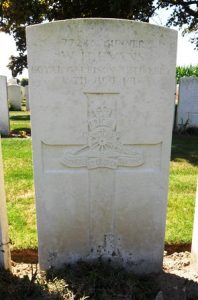
Samuel Glossop, Private, 15865, King’s Shropshire Light Infantry. Samuel was the son of John and Mary Glossop, of 3, Castle Buildings, Llanrhaiadr. He worked as a farm labourer at Glanage, Rhiwlas prior to enlisting into the 7th Battalion, King’s Shropshire Light Infantry at Oswestry soon after the outbreak of war. The battalion formed at Shrewsbury in September 1914, before joining 76 Brigade, 25th Division at Codford, Salisbury Plain. On 28 September 1915 the Division landed at Boulogne, and the entire Division proceeded to Flanders, ordered to relieve the Canadians in the Ploegsteert Wood sector. At the last minute, orders were received for the Division to move to the Ypres sector instead, for instruction alongside the 3rd Division in the Sanctuary Wood trenches, and 76 Brigade then transferred to the 3rd Division. At the end of October, the 3rd Division was relieved and went into reserve for a month, before returning to Ypres to take over the Railway Wood sector. The Division remained here over the winter, its infantry battalions carrying out the usual routines of trench rotation. On 2 February 1916 the 7th KSLI was in the front-line at Railway Wood when Samuel was wounded. He was evacuated to the Casualty Clearing Station at Remi Sidings, where he died of his wounds the following day, 3 February 1916. The 23-year-old is buried in Lijssenthoek Military Cemetery, Belgium.
Hubert James Tudor Hamer, Lieutenant, Indian Army. Hubert was born on 12 February 1883, the son of Captain John Parry Hamer and Sarah Margaret Hamer (nee Tudor), of Glan-yr-Afon Hall, Oswestry. He was privately educated before gaining a commission into the 4th (Militia) Battalion, Royal Welsh Fusiliers, and in 1904 transferred to the regular Royal Welsh Fusiliers. On 28 August 1907 Hubert was commissioned into the King’s (Liverpool Regiment), and transferred to the Indian Army in 1909, joining the 108th Indian Infantry. In September 1914 he was attached to the 101st Grenadiers, and was posted to German East Africa with the battalion. On 4 November 1914, Hubert was leading his Company in an attack on a German held railway terminus at Tanga. Hubert was shot in the neck during the attack, and died instantly. The 31-year-old is buried in Tanga Memorial Cemetery, Tanzania.
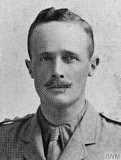
Griffith Edward Hughes, Private, Canadian Infantry. Griffith was the son of John and Mary Hughes, The Cottage, Cefn Canol, Llansilin. By 1911 he was residing with his cousin, David Charles, at The Cottage, Rhydycroesau, and worked as a Grocer’s Carter. According to the Llansilin war memorial, he was killed whilst serving with the Canadian Expeditionary Force, however, nobody of that name served with the Canadians, so no more is currently known of him.
William Jeffreys, Private, 269262, The King’s (Liverpool Regiment). William was born at Chirk on 10 October 1882, the son of Sarah Jeffreys. His mother married Thomas Williams, of Pentregwyn, Llansilin in 1884. William lived at Liverpool with his partner Mary prior to the war. He enlisted into the army under the name of William Jefferies Williams, and was posted to France in the summer of 1917, joining the 12th Battalion, King’s (Liverpool Regiment). The battalion was near Noreuil, facing the Hindenburg Line, and was attached to 61 Brigade, 20th (Light) Division. By 21 July 1917 the Division had moved north to the Ypres Salient, and relieved the 38th (Welsh) Division on the Canal Bank, following the Welshmen’s successful assault on the Pilckem Ridge. The Division then took part in a costly assault on Langemarck, before being relieved by units of the 38th (Welsh) Division on 18 August. The Division then went back into the line at Langemarck on 10 September and suffered a miserable spell in the line over the coming days. The Division remained at Ypres, taking part in the Battles of Langemarck, the Menin Road, and Polygon Wood, before moving south on 2 October, to take part in the Battle of Cambrai, attacking La Vacquerie on 20 November. The Division then took part in the heavy fighting which followed when the Germans counter-attacked at Cambrai, suffering heavy casualties before being relieved and moved south to Albert on the Somme, before entraining for Flanders again, and in the first week of January 1918 took over the line at Tower Hamlets, in the Ypres Salient. In the middle of February, the Division moved again, entraining south to the Somme sector, and took over positions at Berlancourt. The Division was hit hard when the Germans launched the opening phase of their Spring Offensive on 21 March 1918, along the section of front running south from Croisilles to La Fère, and was forced to withdraw over the St Quentin canal. William was killed in action near Dury on the following day, 22 March 1918. The 35-year-old has no known grave and is commemorated on the Pozieres Memorial, France.
Albert Edward Jones, Royal Welsh Fusiliers. The Llansilin war memorial states that Albert served with the Royal Welsh Fusiliers, and resided at Fronfraith. He cannot presently be identified, but an Albert Edward Pierce, of Llansilin, fell during the war and is not named on the memorial. His details can be found further down this page.
David Jones, Pioneer, WR/22400, Royal Engineers. David was the son of David and Elizabeth Jones, of Granite House, Pandy, Glyn Ceiriog. He enlisted into the Royal Engineers, and served with the Roads and Quarries Companies of the Royal Engineers in France. Little else is currently known of his wartime service, but David returned home following the Armistice, and died at Chirk Hospital on 4 September 1919, following several weeks of illness. The 27-year-old is buried in Tregeiriog Cemetery, but is not commemorated as a casualty of war by the CWGC. His brother, Wilfred, had been killed at Mametz Wood in 1916.
Hugh Griffith Jones, Private, 268096, Royal Welsh Fusiliers. Hugh was born in Barmouth in 1896, the son of John Gwion Jones and Elizabeth Jones. The family had moved to the Rhiwlas School House by 1901, after Hugh’s father had gained the position of Schoolmaster. Hugh followed his father into the teaching profession, and had qualified as a teacher prior to enlisting into the Royal Welsh Fusiliers on 28 January 1916 and was sent to Kinmel Park for training. He was originally posted to the 3rd (Garrison) Battalion, Royal Welsh Fusiliers, before being transferred to the Labour Corps, and remained on home service, as his health was beginning to fail. Hugh was diagnosed as suffering from pulmonary tuberculosis, and was discharged from the army as medically unfit on 4 January 1918, and returned to Rhiwlas before he gained a post as assistant master at Llanrhaiadr. Sadly, Hugh contracted influenza later that year, and he died on 15 November 1918, just four days after the death of his youngest sister. The 22-year-old was buried in Dyffryn, Merioneth, alongside his sister. Hugh is not commemorated as a war casualty by the CWGC.
Wilfred Jones, Private, 19389, Royal Welsh Fusiliers. Wilfred was the son of David and Elizabeth Jones, of Granite House, Pandy, Glyn Ceiriog. He worked as a quarryman at Ruabon prior to the war. Wilfred enlisted at Llangollen into the 16th Battalion, Royal Welsh Fusiliers soon after the outbreak of war. The battalion was raised at Llandudno by the Welsh National Executive Committee from a cadre from the 13th Battalion, joining 128 Brigade, 43rd (Welsh) Division and trained in North Wales before moving to Winchester in the summer of 1915, where the formation became renumbered 113 Brigade, 38th (Welsh) Division. The Division moved to France on 2 December 1915 and moved to the Nursery Sector near Fleurbaix for trench initiation alongside the Guards Division. The Division then held a sector of the line near Cuinchy before marching south to the Somme sector in June 1916 to take part in the assault on Mametz Wood. The first attack on the wood was launched on a two-battalion front on 7 July, but failed, and the Divisional Commander, Sir Ivor Philipps, was replaced before the Division attacked again on a two Brigade front on 10 July 1916. Wilfred was killed in action during the assault that day. The 21-year-old has no known grave and is commemorated on the Thiepval Memorial, France.
John Richard Lewis, Private, 55767, Welsh Regiment. John was born in Melbourne, Australia on 21 March 1893, the son of John Lewis. By 1909 the family had moved back to their native Llansilin, and John and his sister Mary were living with relatives at Tycrwyn, Llanfyllin. John worked as a farm labourer at Mount, Sychten prior to the war. He enlisted at Oswestry into the King’s Shropshire Light Infantry, and during the spring of 1917 was drafted to France, where he was transferred to the 10th Battalion, Welsh Regiment. The battalion had been raised in the Rhondda Valley, and was attached to 114 Brigade, 38th (Welsh) Division, which was by then holding the Canal Bank Sector at Ypres. The infantry battalions of the Division had spent much of their time here carrying out the normal pattern of rotation in the trenches, four days in the front, four in support and four in reserve, whilst also working on trench improvement, digging new trenches, and also carrying out regular patrols and trench raids. On 31 July 1917 the Division launched its famous assault on the Pilckem Ridge, with the 10th Welsh on the right flank of the Divisional assault, and over the coming hours the battalion captured its objectives of Caesar Support and Candle Trench, before consolidating its gains. The battalion then spent the rest of the day carrying water and supplies to the 14th and 15th Welsh, which took over the new front line. This hard work continued over the following two days, until the shattered battalion was relieved, and the survivors withdrew to L2 South. John had been killed in action at some time between the 31 July and 2 August. The official date of his death was later accepted to have been 2 August 1917. The 24-year-old is buried in Artillery Wood Cemetery, Belgium.
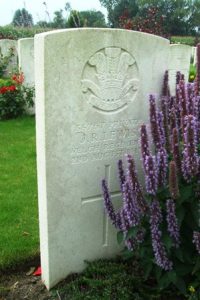
Robert Owen Lloyd, Gunner, 172108, Royal Field Artillery. Robert was the son of Robert and Jane Lloyd, of Tregeiriog Mills, Tregeiriog. He worked for his father at the family mill prior to the war. Robert enlisted at Wrexham into the Royal Field Artillery, and after completing his training was drafted to France to join A Battery, 86th Brigade, Royal Field Artillery. The battery was attached to the 19th (Western) Division until 23 January 1917, when it became an Army Field Artillery Brigade. The battery then moved from the Somme to the Arras sector, to support the Battle of Arras from positions at Gavrelle, then at the end of May moved to Ypres, where it remained until February 1918, supporting the troops attacking at the Battle of Messines then during the entire Passchendaele offensive. The Battery then moved south, to positions near Péronne, where it took part in the desperate defensive action which followed when the Germans launched their Spring Offensive of 21 March 1918. Once the offensive had petered out, the battery moved to the Villers-Bretonneux area, where it remained until the launching of the great Allied offensive on 21 August 1918. Robert took ill some weeks after the launching of the offensive, and died of broncho-pneumonia at the 10th General Hospital, Rouen on 28 October 1917. The 27-year-old is buried in St. Sever Cemetery Extension, Rouen, France.
William Morgan, Lance Corporal, P/7170, Military Foot Police. William was born on 9 March 1892, the son of Charles and Margaret Morgan, of Bryn Llunwy Cottage, Llansilin. His father was a gamekeeper, and William followed in his profession, becoming a gamekeeper himself by 1911. On 15 April 1915 William married Mary Charles, and the couple set up home at Clifton House, Llansilin, where their two children were born. William enlisted into the Montgomeryshire Yeomanry at Llanrhaiadr on 11 December 1915, and was placed on the Army Reserve. On 7 April 1916 he was mobilised, and attested at Wrexham, before being posted to the 3/1st Battalion, Montgomeryshire Yeomanry, at Park Hall Camp, Oswestry. William was transferred to the Military Foot Police on 27 January 1917, and was based at Park Hall, where he remained for the duration of the war. Just weeks before the Armistice, William took ill, and contracted influenza. He was taken to the Military Hospital at Selattyn, where he died on 8 November 1918. The remains of the 26-year-old were brought home, and he was buried in St. Silin’s Churchyard, Llansilin on 12 November 1918, the day after Armistice Day.
Arthur Morris, Private, 355067, Royal Welsh Fusiliers. Arthur was the son of Edward and Ann Morris of Tŷ Du, Llansilin. He worked as a carpenter prior to the war. Arthur had enlisted into the Montgomeryshire Yeomanry at Llangedwyn on 20 March 1912, and had attended the Annual TA Summer Camps over the coming years. On 5 August 1914 the Montgomeryshire Yeomanry was mobilised at Welshpool, as part of the South Wales Mounted Brigade, before moving via Hereford to Thetford, to join the 1st Mounted Division. On 4 March 1916 the 1st Mounted Division sailed for Egypt to join the EEF. On 4 March 1917 the battalion merged with the Welsh Horse Yeomanry to form the 25th (Montgomery & Welsh Horse Yeomanry) Battalion, Royal Welsh Fusiliers, as part of the newly formed 231 Brigade, 74th (Yeomanry) Division. The Division assembled in Egypt as part of the EEF, before crossing the Suez Canal into the Sinai, and saw its first major action during the Second Battle of Gaza. The battle was a failure, and the EEF was re-organised under a new commander, Sir Edmund Allenby, before launching the Third Battle of Gaza on the night of 31 October 1917. This assault was launched along a winder front, running from Gaza to Beersheba, and this time the EEF prevailed, opening the door to Jerusalem. The Division then took part in the drive north into Syria, but as a result of the heavy losses suffered in France, following the launching of the three German Spring offensives from 21 March 1918, was sent to France, landing in Marseilles on 7 May 1918. The Division underwent a system of training, to prepare it for the vastly different conditions on the Western Front, before taking over a section of the front in the St. Floris Sector, moving into the front line between the La Bassée Canal and the River Lys, with the left resting on the small village of Corbie. The Division faced the recently lost town of Merville, some 3,000 yards away. To the south, the Allies launched their offensive on 21 August 1918, and began the great advance towards the Hindenburg Line. The 74th Division was transferred south to join the offensive and assembled around Beaucourt Chateau, before moving forwards to take part in the attack on the Hindenburg Line outer defences, reaching the towns of Lempire and Ronssoy, launching an assault on the German positions there on 18 September 1918. Arthur was killed near his battalion’s objective of Orchard Post during the attack that day. The 30-year-old is buried in Ronssoy Communal Cemetery, France.
John Morris, MC, Major, Royal Army Medical Corps. John was born on 20 February 1879, the son of Thomas Morris and Mary Ellen Morris (nee Hughes), of Llansilin. He trained as a Surgeon at Edinburgh University, graduating in 1904, and had been assistant surgeon to the Dinorwic Quarries Hospital and as house-surgeon of the Denbighshire Infirmary, by 1905. John married Ellen Mary Cooper in 1910, and the couple lived at Boston Bank, Hyde, Cheshire, where John had started his own practise. He enlisted into the Territorial Army on 8 March 1912, and became the Medical Officer to the 6th Battalion, Cheshire Regiment. John embarked for France on 10 November 1914, and by August 1915 had been promoted to Captain, then later to Major. He was awarded the Military Cross in the New Year Honours List of 1 January 1917. Twelve months later he had been promoted to Major, and was serving with the 132nd Field Ambulance, RAMC, as second-in-command. The unit was attached to the 39th Division, but following heavy losses by the Division during the Spring of 1918, it was removed from the line, and the 132nd FA left the Division in June 1918, moving to Abbeville to re-equip, before moving to Flanders to train US Army Medical Units. On 4 September 1918 the 132nd FA entrained for the front again, to join the great Allied offensive. On 5 October 1918 the 132nd FA moved forward to Templeux-le-Guerard, taking over from the 6th Australian Field Ambulance. John was sent with the advance party to begin setting up the unit, and to take over command of the Ambulance once it had set up, ready to take further casualties. During the afternoon of 7 October 1918, John was visiting a forward Regimental Aid Post when he was killed. His body was carried back by men of his unit, and the 39-year-old was buried in Bellicourt British Cemetery, France.
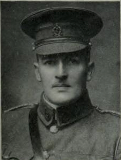
Robert Humphrey Morris, Private, 69354, Cheshire Regiment. Robert was the son of John Morris and Hannah Morris (nee Humphreys), of Hirnant. He married Mary Jones at Llangynog on 13 June 1910, and the couple set up home at Gelli Ganol, Hirnant, where their only daughter was born the following year. Robert worked as an agricultural labourer prior to the war. He enlisted into the Herefordshire Regiment, and was originally posted to the 1st Battalion, King’s Shropshire Light Infantry, serving in France with the battalion before being transferred to the Cheshire Regiment. Robert survived the war and returned home, but his health had suffered as a result of his service, and he died on 12 December 1922. The 36-year-old was buried in St. Silin’s Churchyard, Llansilin on 15 December. Robert is not commemorated by the CWGC, nor is he commemorated among the fallen on the Llansilin war memorial, however he is listed among those who served.
Samuel Morris, Private, 266917, Welsh Regiment. Samuel was the son of Edwin and Mary Morris, of Cam Helyg Ucha, Pandy, Glyn Ceiriog. He worked as a labourer and lived at Camhelig, Pandy, prior to enlisting at Chirk into the Royal Welsh Fusiliers. After he completed his training, Samuel was drafted to France in the summer of 1917, and was transferred to the 1/6th Battalion, Welsh Regiment. The battalion had been one of the first Territorial battalions in France, and by May 1916 had been made the Pioneer Battalion to the 1st Division. Samuel probably joined the battalion at Oost-Dunkerque, on the Flanders coast, where the Division had been sent to prepare for a possible offensive. However, the Passchendaele offensive had bogged down, and the Division was sent to Ypres at the end of October 1917, reaching Brielen on 1 November, where the 6th Welsh immediately began work on road maintenance, NE of Ypres, before moving to Boesinghe, and worked on wiring and defensive work, as well as clearing the Steenbeek. This hard work continued over the coming weeks, with bridges being erected over the Steenbeek, the Bronbeek, the Loobeek and the Lekkerbotterbeek, as well as mor work on road repair. In February 1918 the 6th Welsh moved into Turco Camp to work on a different area and on 8 April the 6th Welsh moved out of the area into billets in Bethune. Samuel was killed here by enemy shellfire on 13 April 1918, during the peak of the German Lys offensive. The 25-year-old is buried in Bethune Town Cemetery, France.
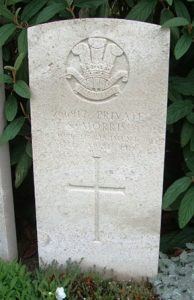
Thomas Morris, Private, 22414, South Lancashire Regiment. Thomas was the son of Edward and Elizabeth Morris, of Tynant, Llansilin. He worked as a cowman prior to the war. Thomas enlisted into the Montgomeryshire Yeomanry at Wrexham soon after the outbreak of war, but was then transferred to the 13th Battalion, South Lancashire Regiment. The battalion had formed at Oswestry in September 1915, from depot Companies of the 11th Battalion, and in November 1915 moved to Prescot to join the 16th Reserve Brigade. By April 1916 the battalion had moved to Altcar Camp, Merseyside. Thomas had not been at Altcar long when he became ill, and was invalided to The Grange Voluntary Aid Hospital, Southport, Lancashire, where he died of pneumonia on 29 May 1916. The remains of the 25-year-old were brought home for burial with full military honours at St. Silin’s Churchyard, Llansilin on 1 June 1916.
Albert Edward Pierce, Private, 55494, Royal Welsh Fusiliers. Albert was born on 30 March 1895, the son of Edward and Harriet Pierce, of 1, Tanat Cottages, Llanyblodwell. He lived at Fronfraith, Llansilin and worked for the Great Western Railway prior to the war. Albert enlisted at Welshpool into the Royal Welsh Fusiliers, and was posted to Kinmel Park for training. During the winter of 1916-17 he was drafted to France, and posted to the 17th Battalion, Royal Welsh Fusiliers. The battalion was in the Canal Bank sector at Boesinghe, north of Ypres, attached to 115 Brigade, 38th (Welsh) Division, having moved there following the divisions assault on Mametz Wood in July 1916. The infantry battalions of the Division then began carrying out the normal pattern of rotation in the trenches, four days in the front, four in support and four in reserve, whilst also working on trench improvement, digging new trenches, and also carrying out regular patrols and trench raids. On 31 July 1917 the Division launched its famous assault on the Pilckem Ridge, capturing Iron Cross and reaching its objective of the Steenbeek, then played a supporting role in the Battle of Langemarck. The Division was transferred to the Sailly-sur-la-Lys sector in September, and remained in the area over the winter before being moved to positions north of Albert, at Bouzincourt Ridge, at the end of March 1918, relieving the battered 2nd and 47th Divisions. It held this sector, again carrying out minor operations and trench raids, over the coming months, before taking part in the great offensive of 21 August 1918, and began its advance towards the Hindenburg Line. Following the breaking of the Hindenburg Line in October, the Division advanced past Le Cateau towards the mighty Forest of Mormal. Albert had taken ill by now, and was evacuated to the 3rd Casualty Clearing Station, where he died of influenza on 1 November 1918. The 23-year-old is buried in Rocquigny-Equancourt Road British Cemetery, Manancourt, France. Albert appears to be the man commemorated on the Llansilin war memorial at Albert Edward Jones.
Herbert Richards, Private, 43006, King’s Shropshire Light Infantry. Herbert was the illegitimate son of Elizabeth Richards, of Upper Sweeney Farm, Llansilin. He was raised by his grandparents at Upper Sweeney. Herbert worked at Mardy prior to enlisting at Porth, Rhondda into the King’s Shropshire Light Infantry. Herbert was posted to France in the summer of 1918, joining the 7th Battalion, King’s Shropshire Light Infantry, which was in the Locon Sector, attached to 76 Brigade, 3rd Division. The Division was rebuilding following heavy losses during the German offensives, and during August 1918 moved south to take part in the great offensive. On 21 August 1918 the Allies launched a massive offensive along much of the Western Front, and the 3rd Division launched its assault from the direction of Monchy-au-Bois towards its objectives along the Arras to Bapaume railway towards Courcelles. The advance continued over the coming days, with the line pushing past Beugny to Havrincourt by 16 September. On 30 September the 7th KSLI moved into the front line at Masnières, and on the following morning took part in the continued advance. The 7th KSLI was in trenches east of Flesquières, and took part in an assault by 76 Brigade on 1 October, capturing Rumilly before the battalion advanced through the village to develop a new line. Herbert was killed in action here on 3 October 1918. The 24-year-old has no known grave and is commemorated on the Vis-en-Artois Memorial, Haucourt, France.
Edwin Andrew Roberts, Private, 13716, King’s Shropshire Light Infantry. Edwin was the son of Edward Roberts and Mary Roberts (nee Morris), of Cilrhew, Moelfre. He worked as a labourer prior to the war. Edwin enlisted into the 8th Battalion, King’s Shropshire Light Infantry at Newport, Monmouthshire soon after the outbreak of war. The battalion had formed at Shrewsbury in September 1914, before joining 66 Brigade, 22nd Division at Seaford. On 5 September 1915 Edwin landed in France with the battalion, which then proceeded to Hébuterne, in the the Somme sector, before the entire Division assembled around Fouilloy. The 8th KSLI then moved to billets in Bayonvillers, before the Division moved into the line in front of Foucaucourt. Just weeks later the Division received orders to pack up and entrained for Marseilles on 26 October, before embarking there for Salonika aboard the SS Huntsend. The British and French had moved several divisions there as a result of a combined Austrian and Bulgarian invasion of Serbia, which had driven the Serbian army back across the Greek border. The 22nd Division arrived there on 6 November, before moving to the new front, taking part in the retreat from Serbia the following month. Between 10 to 18 August 1916 the Division fought at the battle of Horseshoe Hill, then between 13 to 14 September 1916 at the battle of Machukovo. Edwin took ill during the summer of 1916, just after the latter battle, and died of dysentery on 14 October 1916. The 32-year-old is buried in Salonika (Lembet Road) Military Cemetery, Greece.
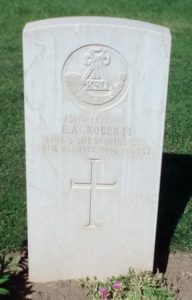
Richard Rogers, Private, 12251, King’s Shropshire Light Infantry. Richard was the son of Robert and Mary Rogers, of Pentrecwn, Llansilin. He worked as a cowman prior to the war. Richard enlisted at Oswestry into the 6th Battalion, King’s Shropshire Light Infantry soon after the outbreak of war. The battalion formed at Shrewsbury in September, joining 60 Brigade, 20th (Light) Division at Aldershot. After training at Larkhill, Salisbury Plain, on 22 July 1915 the battalion landed at Boulogne, and the entire Division moved to the Fleurbaix Sector for trench familiarisation and training. When the Battle of Loos was launched on 25 September 1915 the Division fought a diversionary attack towards Fromelles. Later that year the Division moved north, and fought at the Battle of Mount Sorrel alongside the Canadian Corps. The Division then fought through the Somme Offensive, at the Battles of Delville Wood, Guillemont, Flers-Courcelette, Morval and Le Transloy, and took part in the advance to the Hindenburg Line in March 1917. Later that year the Division fought at Third Ypres, at the Battles of Langemarck, the Menin Road, and Polygon Wood, before moving south in November, to take part in the Battle of Cambrai. The Division remained in the area between Cambrai and St. Quentin over the winter of 1917/18 and was hit there by the German Spring Offensive of 21 March 1918. The battered Division was then relieved and moved to the Caucourt area to rest and rebuild. By 3 May 1918 the Division moved back into the line in the Avion Sector, and its infantry battalions began the usual routines of rotating in the trenches. Richard was killed during a routine spell in the line when the Germans launched a barrage of gas shells upon the battalions’ positions on 14 May 1918. The 23-year-old was struck by shrapnel and killed instantly. He is buried in Sucrerie Cemetery, Ablain-St. Nazaire, France. His brother, Robert, had been killed in France the previous year.
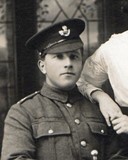
Robert Thomas Rogers, Private, 739148, Canadian Infantry. Robert was born on 21 January 1891, the son of Robert and Mary Rogers, of Pentrecwn, Llansilin. He had served for three years with the Montgomeryshire Yeomanry prior to emigrating to Canada before the war and worked as a farmer in Ontario. Robert enlisted into the 114th Overseas Battalion, Canadian Expeditionary Force on 14 December 1915 and sailed from Halifax with the battalion for England on 31 October 1916. In February 1917 he was posted to France, and joined the 19th Battalion, Canadian Infantry, which was attached to the 4th Infantry Brigade, 2nd Canadian Division. The Division was north of Arras, in the Vimy area, and was preparing to launch their famous assault on the heights of Vimy Ridge. The assault was launched on 9 April 1917, and after intense fighting, the Canadians stormed the ridge, before advancing towards Arleux. Robert survived the ordeal of Vimy Ridge, but his battalion was to see even worse suffering a month later after relieving the 28th and 29th Battalions in the front lines near Fresnoy on the morning of 8 May. The relief was almost complete when the Germans launched a ferocious artillery and infantry assault against Fresnoy, and the 19th Battalion suffered terrible casualties during their heroic defence. Robert was hit in the head by shrapnel just before his battalion was relieved on the following day, 9 May 1917, and died on his way to the dressing station. The 27-year-old has no known grave, as the area was thoroughly bombarded during the coming weeks and any graves in the area were obliterated, so he is commemorated on the Vimy Memorial, France. His brother, Richard, was killed in France twelve months later.
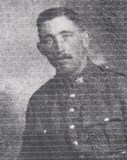
Richard Vaughan, Private, 17435, King’s Shropshire Light Infantry. Richard was born at Llansilin in 1886, the son of Edwin and Laura Vaughan. After his father’s death in 1900, Laura moved with her children to 4, Swan Crescent, Oswestry. Richard worked as a labourer prior to enlisting at Oswestry into the Royal Welsh Fusiliers on 15 August 1914, and was posted to the Depot at Wrexham, but was discharged as medically unfit on 15 October. He then re-enlisted into the East Lancashire Regiment on 19 December 1914 and was posted to Shrewsbury Barracks, where he had his medical, before being sent to Preston Barracks, joining the 3rd Battalion, East Lancashire Regiment. On 4 February 1915 Richard was discharged as medically unfit, due to having bad teeth. Undeterred, he re-enlisted into the 5th Battalion, King’s Shropshire Light Infantry. The battalion was at Aldershot, attached to 42 Brigade, 14th (Light) Division. On 20 May 1915 the battalion landed at Boulogne, and the entire Division assembled in the Ypres Salient, before taking over the Zillebeke Sector. The Division was to see its first action during the Action of Hooge, where it became the first Division to be attacked by the German use of flamethrowers. The Division then fought at the Second attack on Bellewaarde, before moving to the Arras sector by March 1916. At the beginning of August 1916, the Division moved further south to the Somme sector, and by 12 August the 5th KSLI had reached a tented camp at Fricourt. On 18 August the battalion moved to Pommiers Redoubt, and on the following day proceeded to Montauban Alley, before taking over front-line trenches at Delville Wood on 21 August. The battalion endured a torrid time over the coming days, suffering incessant artillery fire, before launching an assault against Beer Trench, together with the rest of 42 Brigade, on 24 August 1916. Richard was killed in action during the assault that day. The 29-year-old has no known grave and is commemorated on the Thiepval Memorial, France. Richard is not commemorated on the Llansilin war memorial.
David Williams, Private, 18247, King’s Shropshire Light Infantry. David was the son of Edward and Sarah Williams of Gravel Hill, Moelfre, Llansilin. He worked as a cowman at Whittington, and married Emily Robinson there in 1912. David enlisted into the 5th Battalion, King’s Shropshire Light Infantry at Oswestry soon after the outbreak of war. The battalion formed at Shrewsbury, before moving to Aldershot, joining 42 Brigade, 14th (Light) Division. On 20 May 1915 the battalion landed at Boulogne, and the entire Division assembled in the Ypres Salient, before taking over the Zillebeke Sector. The Division was to see its first action during the Action of Hooge on 30 July 1915, where it became the first Division to be attacked by the German use of flamethrowers. The Division then fought at the Second attack on Bellewaarde, a diversionary assault launched on 25 September 1915, in an attempt to divert German attention away from the main offensive at Loos. The 5th KSLI alone suffered 420 casualties during the attack, before being relieved the following day. The 14th Division remained at Ypres over the winter. On 31 January 1916 the 5th KSLI moved back into the front line to begin a routine spell in the trenches. On 2 February 1916 their positions were shelled by the Germans, killing David and six other men from the battalion. David was 28-years-old when he was killed that day. He has no known grave and is commemorated on the Ypres (Menin Gate) Memorial, Belgium. Two of his brothers, John and Percy Williams, also lost their lives during the war.
David Caradog Williams, Rifleman, 26/1750, New Zealand Rifle Brigade. David was the son of Hugh Solomon Williams, Headmaster of Llansilin School, and Elizabeth Williams, of Oakdene, Llansilin. He was working as a Clerk at Saddleworth by 1911, then moved to New Zealand, where he had gained work as a Clerk at the Patea Farmers Co-Op. On 10 January 1916 David enlisted into the New Zealand Expeditionary Force, and was posted to the 4th Battalion, 3rd New Zealand Rifle Brigade. The battalion had sailed for Egypt, before moving to the Western Front, and David joined the battalion among a draft of re-enforcements on 30 July 1916. By now the New Zealanders had moved to the Somme sector, to join the great offensive, and saw their first major action in France during the Battle of Delville Wood. David was badly wounded on 13 September 1916 and was evacuated to a Casualty Clearing Station near Mametz Wood, where he died later that same day. The 23-year-old is buried in Flatiron Copse Cemetery, Mametz, France.
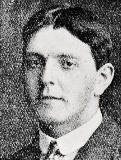
John Williams, Private, 291857, Royal Welsh Fusiliers. John was the son of Edward and Sarah Williams of Gravel Hill, Moelfre, Llansilin. He worked as a cowman prior to enlisting into the 3/7th Battalion, Cheshire Regiment at Whittington on 18 November 1915. The battalion was a reserve unit, which had been formed at Oswestry, so John trained locally. On 13 July 1916 he embarked at Devonport for Egypt, disembarking at Alexandria on 24 July, before joining the Infantry Base Depot. On 3 August 1916 John was posted to the 1/7th Battalion, Royal Welsh Fusiliers. The battalion was on the Suez Canal Defences, attached to 158 Brigade, 53rd (Welsh) Division, and had seen service at Gallipoli the previous year. Once the Suez Canal had been secured, the EEF turned its attention onto driving the Turks out of Palestine, and on 26 March 1917 launched its first offensive against the coastal city of Gaza, which guarded the road to Jerusalem. Initial gains during the day were lost when the assaulting divisions lost touch with each other and communication broke down when a thick fog cloaked the battlefield. A second attempt to force Gaza was launched on 17 April, which also failed, and the EEF suffered a change in leadership, with Sir Edmund Allenby assuming command, before being re-organised, and a third offensive was launched against a wider front from Beersheba to Gaza on 31 October 1917. In the meantime, John had taken ill, and had been evacuated to Hospital in Cairo. He died of dysentery in Cairo on 26 August 1917. The 25-year-old was buried in Cairo War Memorial Cemetery, Egypt. Two of his brothers, David and Percy, also fell during the war.
Percy Williams, Private, 127572, Machine Gun Corps. Percy was the son of Edward and Sarah Williams of Gravel Hill, Moelfre, Llansilin. He enlisted at Wrexham into the Royal Welsh Fusiliers, and after completing his training was drafted to France, where he was posted to the 56th Battalion, Machine Gun Corps. The battalion had formed on 1 March 1918, attached to the 56th (London) Division, which was facing the Hindenburg Line, and saw its first major action following the launching of the German Spring offensive, along the section of front line running south from Croisilles to La Fère, on 21 March 1918. The battered Division then moved north to rebuild in the quieter Arras Sector, and the 56th MGC moved to No 2 Camp, Warlus and immediately began work, providing harassing fire on known German positions facing the Division. On 21 August 1918 the Allies launched a massive offensive along the Western Front, and began driving towards the mighty Hindenburg Line. The 56th MGC moved forwards to Blaireville two days later to join the offensive, and assisted the Division in its drive towards St. Leger. The Division soon reached the Hindenburg Line and began its attacks against the strongly defended positions by the end of the month, seeing heavy fighting around Bullecourt. Percy was wounded near Villers Cagnicourt during the last days of September, and was evacuated to the 23rd Casualty Clearing Station, where he died of his wounds on 1 October 1918. The 20-year-old is buried in Duisans British Cemetery, Étrun, France. Percy lost two of his brothers, David and John Williams, during the war.
Peter Trevor Williams, Private, 79610, Devonshire Regiment. Peter was born on 6 February 1896, the son of William and Margaret Williams of Tynybwlch, Llansilin. His father was the carpenter on the Llangedwyn Estate. Peter enlisted into the army, and was posted to the 15th Battalion, Devonshire Regiment. The battalion had been formed on 1 January 1917 from the 86th Provisional Battalion and moved to Herne Bay. During 1918 the battalion moved to Aldeburgh where it remained. Peter died in Norfolk War Hospital, Thorpe St. Andrew on 7 July 1918. The remains of the 22-year-old were conveyed home for burial in St. Cedwyn’s Churchyard, Llangedwyn.
World War Two, 1939-1945
Albert Reynolds, Private, 1808363, The Queen’s Royal Regiment (West Surrey). Albert was the son of James and Mary Ann Reynolds, of Groesffordd, Llangedwyn. He enlisted into the army and was posted to the 2/6th Battalion, The Queen’s Royal Regiment (West Surrey). The battalion had fought during the fall of France in 1940, attached to 169 (Queen’s) Brigade. In 1942 the battalion embarked for North Africa with the brigade, and joined the 56th London Division, before taking part in the capture of Tunis in May 1943. The brigade then took part in the allied landing at Salerno, Italy in September 1943, before taking part in the slow advance north through Italy. Albert was killed in Italy on 12 November 1944. The 23-year-old is buried in Ancona War Cemetery, Italy.